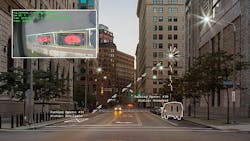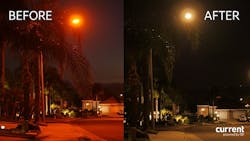San Diego has added to it LED street-light portfolio and to sensor-enabled wireless controllers for a variety of public service applications, while a coalition of municipalities in the so-called Inland Empire have struck a unique financial deal to purchase street light assets from utilities and migrate to SSL.
Current, powered by GE has announced an expansion of its LED street-light projects in Southern California with the latest work spanning benefits including energy efficiency, accurate billing, Internet-of-Things (IoT)-enabled smart city applications, creative financing, and dark-sky friendly solid-state lighting (SSL). The city of San Diego is in the midst of growing its wirelessly-connected street light portfolio to 14,000 nodes, and more than 4000 of those poles will also feature Current CityIQ nodes for IoT functionality. Meanwhile, the Western Riverside Council of Governments (WRCOG) is managing the efforts of eleven Riverside County municipalities to purchase street lighting assets from utility Southern California Edison (SCE), and retrofit those street light poles with LED luminaires from Current. The projects indicate that it is business as usual at Current despite the fact that the company is set to be acquired by American Industrial Partners (AIP).
Urban San Diego
The San Diego project covers areas in downtown including the historic Gaslamp District and stretching to urban communities around the city core. The street light portfolio includes the historic acorn-style luminaires that are the namesake of the Gaslamp and other areas of downtown, and cobra-head-style luminaires on busy roads downtown and in the urban area. The city is in the final phase of bringing the total connected luminaire installed base to 14,000.
More than 3000 of the retrofitted street light poles also have what Current calls CityIQ nodes installed. And the city plans to add another thousand in the next year. As was the case in a Portland, OR trial that we reported on, the CityIQ node is not integrated into the luminaire but is a separate module with its own dedicated wireless link based on AT&T LTE 4G cellular technology. On the acorn-style poles, the CityIQ nodes are installed in line with the pole, between the pole and the luminaire. Or in some cases where one pole suspends two acorn-style luminaires from above on either side of the pole, the node is mounted to the bottom of the luminaire. In the case of cobra-head luminaires, the node is installed at the end of the boom just behind the luminaire.
The CityIQ nodes were developed by Current with help from Intel. The nodes integrate both forward- and rear-facing cameras, providing a 360° view around the pole. Processing such video requires significant intelligence at the edge of the network and thus the inclusion of an Intel microprocessor. Moreover, when video must be transferred across the wireless network, a fast link is required. For that and other logistics reasons, Current has found it simpler to have a dedicated cellular link in its node, as opposed to relying on an existing street light network, and has plans to upgrade to 5G technology in the future. Many of the mesh schemes used to network street lights rely on much lower-speed wireless technology.
San Diego has not released full details on the smart-city applications that it is using. But the list will include parking enforcement and services, citizen safety, and more. The city said it is using software from Genetec that aids in first responder response time and Xaqt that enables analysis of traffic patterns.
Even the connected street lights that do not include a CityIQ node have some unique features including the integration of a utility-grade meter to accurately determine how much power each street light uses. Meters integrated in street lights have been a contentious topic as we discussed in an article on the Street & Area Lighting Conference (SALC) 2017. Utilities fear inaccuracy will cost them revenue. But San Diego believes it will save an additional $250,000 annually via more accurate metering.
Inland Empire
Moving to what is often called the Inland Empire located east of Los Angeles in California, the WRCOG initiative is intended to deliver $60 million in energy and maintenance savings over a 20-year period. The project across the eleven municipalities will include a total of 55,000 luminaires.
There are many interesting elements to the WRCOG projects, including perhaps some control and IoT features down the road. But the most unique aspects of the initiative are the fact that it is based on the participating municipalities buying the street light assets from SCE, and then the fact that the project is taking place in the neighborhood of the Palomar Observatory. And as a recent column indicates, the subject of SSL impact on observatories and the dark sky is a hot topic.
The communities participating in the WRCOG project are generally financing the purchase of the street lights and the installation of the LED lighting. But those municipalities will reap the rewards from energy savings that make the financing possible. Morena Valley is the single largest of the jurisdictions and retrofitting more than 11,000 lights in that area is projected to deliver almost a million dollars each year in savings.
Meanwhile, the WRCOG sought public and observatory imput on the project from the start to build positive consensus. Luminaires from a dozen vendors were installed at a trial site before the Current Evolve products were selected. The Evolve luminaires combine LED and reflector technology to minimize glare and uplight. And ultimately Palomar Observatory approved of the installation.
“The community involvement and rigor of this project is really a model for cities and towns nationwide,” said RJ Darling, general manager of roadway solutions at Current. “WRCOG showcases the strength of communities working together to benefit both the short and long-term interests of citizens.”







